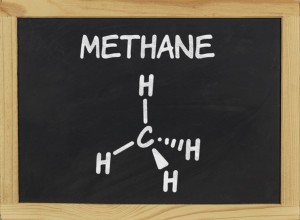 Pretty much every recent news article you’ve read about the global warming impact of methane compared to carbon dioxide is wrong. Embarrassingly, everyone from the Environmental Protection Agency itself to the New York Times and Washington Post and Wall Street Journal continue to use lowball numbers that are wrong and outdated. In fact, as we’ll see, they are doubly outdated.
Pretty much every recent news article you’ve read about the global warming impact of methane compared to carbon dioxide is wrong. Embarrassingly, everyone from the Environmental Protection Agency itself to the New York Times and Washington Post and Wall Street Journal continue to use lowball numbers that are wrong and outdated. In fact, as we’ll see, they are doubly outdated.
Here, for instance, is the New York Times from Tuesday [18 August 2015]: “Methane, which leaks from oil and gas wells, accounts for just 9 percent of the nation’s greenhouse gas pollution — but it is over 20 times more potent than carbon dioxide, so even small amounts of it can have a big impact on global warming.”
Here is the EPA’s own news release from Tuesday on its on its proposed new methane rule: “Methane, the key constituent of natural gas, is a potent GHG with a global warming potential more than 25 times greater than that of carbon dioxide.”
In fact, two years ago the Intergovernmental Panel on Climate Change (IPCC) reported in its definitive Fifth Assessment of the scientific literature that methane is 34 times stronger a heat-trapping gas than CO2 over a 100-year time scale, so its long-term global-warming potential (GWP) is 34. That is a nearly 40 percent increase from the IPCC’s previous estimate of 25.
The global-warming potential of methane compared to CO2 over 20 years and 100 years, with and without climate-carbon feedbacks (cc fb). Via IPCC.
If you think that the 20-year GWP (86) might actually be more relevant in a world where we are only decades away from crossing points of no return for key climate impacts, you aren’t alone.
The fact is the 100-year potential has been used in part because scientists have been focused on the long-term warming impact — and the year 2100 is an endpoint for much analysis. But after ignoring the scientists for 25 years, the world really needs to worry that we are likely to cross dangerous tipping points long before then, including the irreversible loss of enough ice on Greenland and Antarctica to raise sea levels perhaps 40 feet or more.
And although the 100-year GWP is by far the most widely used, the IPCC itself drops this mini-bombshell in their 2013 report:
There is no scientific argument for selecting 100 years compared with other choices (Fuglestvedt et al., 2003; Shine, 2009). The choice of time horizon is a value judgement since it depends on the relative weight assigned to effects at different times.
Again, there is no scientific reason to pick the 100-year GWP over the 20-year GWP. The EPA and media outlets should in fact make clear they are talking about the 100-year GWP, and the best media coverage should give the 20-year GWP, since that number is increasingly relevant for humanity.
Returning to the main point, the EPA and New York Times and most other major media outlets are using the wrong global warming potential — one that could easily be fact-checked. How easily? Just Google “global warming potential.” The Wikipedia entry pops up first and in the opening paragraph explains “In the Fifth Assessment Report of the Intergovernmental Panel on Climate Change, methane has a lifetime of 12.4 years and with climate-carbon feedbacks a global warming potential of 86 over 20 years and 34 over 100 years in response to emissions.”
The New York Times statement that methane is “over 20 times more potent than carbon dioxide” uses a figure that is nearly twenty years out of date. And, no, the use of the word “over” doesn’t make their statement defensible any more than if they had written, “basketball superstar Lebron James is over 5 feet tall.”
The EPA use of “more than 25 times” is closer, but would still be like writing, “Lebron James is over 6 feet tall.” He is, in fact, 6 feet 8 inches. Worse, not only has the EPA also been using the two-decade old figure of 20 until recently, they actually know that 25 is the wrong number.
As of July, EPA’s own web page “Understanding Global Warming Potential,” stated, “Methane (CH4) is estimated to have a GWP of 28-36 over 100 years.” You can then click on a link for the next sentence, “(Learn why EPA’s U.S. Inventory of Greenhouse Gas Emissions and Sinks uses a different value.)” There you will learn:
The EPA considers the GWP estimates presented in the most recent IPCC scientific assessment to reflect the state of the science. In science communications, the EPA will refer to the most recent GWPs. The GWPs listed above are from the IPCC’s Fifth Assessment Report, published in 2014.
Oops. I guess EPA doesn’t consider Tuesday’s news release OR the accompanying “fact sheet” OR its “Proposed Rule” that sets new methane standards for “new and modified sources in the oil and gas industry” to be “science communications” — since every single one of those EPA publications uses “25.”
EPA explains its GHG inventory uses “25” because the U.N. Framework Convention on Climate Change (UNFCCC) “guidelines now require the use of the GWP values for the IPCC’s Fourth Assessment Report, published in 2007.” That is pretty strange of the UNFCCC — but no excuse for EPA to use a number it knows is wrong in any other venue.
Sadly, the EPA’s mistake now propagates throughout the media.
Washington Post: “As a greenhouse gas, methane is 25 times as potent as carbon dioxide in trapping heat in the atmosphere.”
USA Today: “Methane — a potent greenhouse gas 25 times more powerful than carbon dioxide at trapping atmospheric heat — is a contributor to global warming.”
Wall Street Journal: “Methane has a warming effect on the planet more than 20 times greater than carbon dioxide, according to the EPA.”
Oops! And “double oops” for the Wall Street Journal. Memo to media: Next time, check Wikipedia. Or the top climate scientists on the planet.
The bottom line is that methane is a superpotent greenhouse gas — especially over the medium-term, a timeframe of growing concern to scientists. The media needs to start getting its facts straight, especially since we know that methane leaks from the entire natural gas lifecycle from fracking to combustion significantly undercut or eliminate any meaningful climate benefit from the fracking boom (see my 2014 post “By The Time Natural Gas Has A Net Climate Benefit You’ll Likely Be Dead And The Climate Ruined”).
Sources:
Coral Davenport, “U.S. Is Set to Propose Regulation to Cut Methane Emissions,” The New York Times (17 August 2015). www.nytimes.com/2015/08/18/business/us-is-set-to-propose-regulation-to-cut-methane-emissions.html
US EPA, EPA Proposes New Commonsense Measures to Cut Methane Emissions from the Oil and Gas Sector/Proposal Cuts GHG Emissions, Reduces Smog-Forming Air Pollution and Provides Certainty for Industry (18 August 2015). yosemite.epa.gov/opa/admpress.nsf/0/E5F2425E2E668A2B85257EA5005176FA
IPCC, WORKING GROUP I CONTRIBUTION TO THE IPCC FIFTH ASSESSMENT REPORT CLIMATE CHANGE 2013: THE PHYSICAL SCIENCE BASIS www.climatechange2013.org/images/uploads/WGIAR5_WGI-12Doc2b_FinalDraft_All.pdf
Wikipedia, “Global Warming Potential.” en.wikipedia.org/wiki/Global-warming_potential
US EPA, Understanding Global Warming Potentials www3.epa.gov/climatechange/ghgemissions/gwps.html
EPA’s Air Rules for the Oil & Gas Industry: Proposed Climate, Air Quality and Permitting Rules for the Oil and Natural Gas Industry: Fact Sheet (18 August 2015). www3.epa.gov/airquality/oilandgas/pdfs/og_fs_081815.pdf
Joby Warrick, “With proposed limits on methane, EPA takes aim at a powerful greenhouse gas,” Washington Post (18 August 2015). www.washingtonpost.com/news/energy-environment/wp/2015/08/18/with-proposed-limits-on-methane-epa-takes-aim-at-a-powerful-greenhouse-gas/
Doyle Rice, “EPA proposes huge methane limits for oil, gas industry,” USA Today (18 August 2015). www.usatoday.com/story/news/nation/2015/08/18/epa-methane-voc-emissions-oil-gas-industry-limits/31920637/
Amy Harder, “EPA to Propose Rules Cutting Methane Emissions From Oil and Gas Drilling: Agency to call for 40%-45% cut in methane emissions by 2025,” The Wall Street Journal (17 August 2015). www.wsj.com/articles/epa-to-propose-rules-cutting-methane-emissions-from-oil-and-gas-drilling-1439852519
Joe Romm, “By The Time Natural Gas Has A Net Climate Benefit You’ll Likely Be Dead And The Climate Ruined,” think progress (19 Feb 2014). thinkprogress.org/climate/2014/02/19/3296831/natural-gas-climate-benefit/
This Commentary was originally published in Climate Progress (20 August 2015). thinkprogress.org/climate/2015/08/20/3692726/epa-wrong-methanes-warming-impact/




No comments yet, add your own below